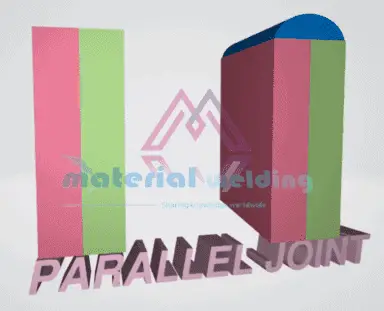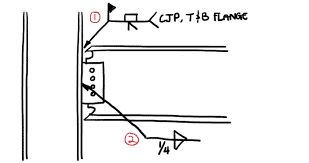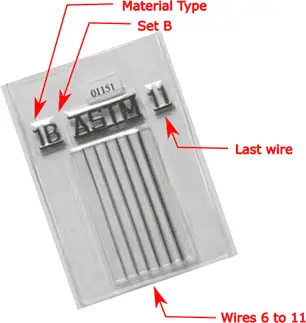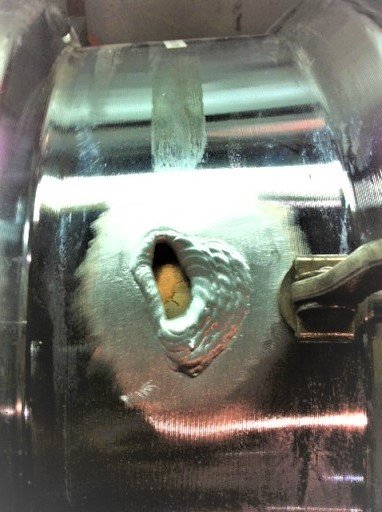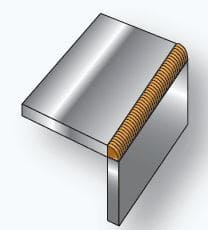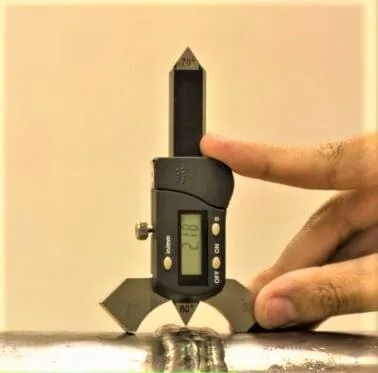Plug Weld Meaning
A Plug Weld is type of weld deposited in a round hole in one plate of a welding joint joining that plate to another overlapping plate. Weld is deposited in a hole made in uppermost overlapping plate.
Plug welding connects the surface of a section of one material to another through a hole. The hole may be partially or completely filled with weld material. If you weld a Fillet weld in this hole instead of completely filling it, it will not be considered as Plug Weld.
How to decide a Plug Weld Size & its Dimensions?
Plug weld size is equal to the weld metal diameter made in the plug weld hole. The minimum size of a plug weld as per the standard requirements are given in this post later.
The effective load bearing area of a plug weld is directly represented by the nominal hole area. (This opposite to effective area of a filet weld that is equal to throat size multiplied by fillet weld length.)
Recommended dimensions of a Plug weld is:
Diameter of the plug weld hole … d ≥ 2s
Groove width … d ≥ 2s
Groove length … L ≥ 2d
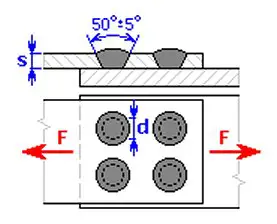
Plug weld Strength Calculation
For plug welds, there may be two types of Problems:
1) shear on the base surface of the weld,
2) tearing in the peripheral surface of the weld.
When controlling resistance, it is necessary to take into consideration the two possible types of problems. The resulting nominal stress in the welding is determined by the equation:
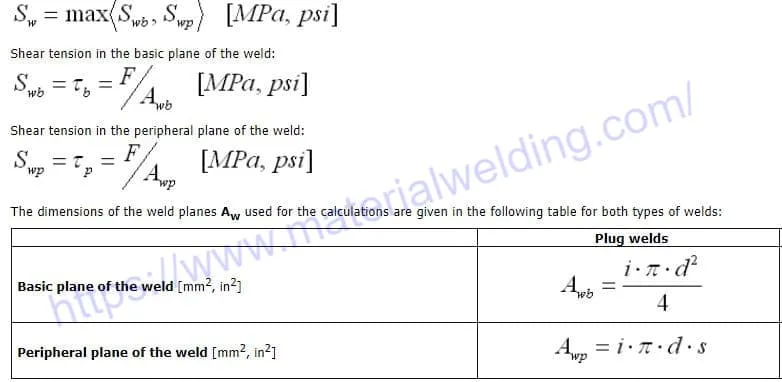
where:
F …. Force exerted [N, lb],
d …. Diameter of the orifice, or width of the groove [mm, in],
i ….. Number of welds in assembly,
L …. Groove length [mm, in],
s …. Sheet thickness [mm, in].
Plug Weld and Slot Weld
A plug weld and a slot weld appear comparable in design, but a plug weld is made in a round hole while slot weld is welded in a slot elongated in one way.
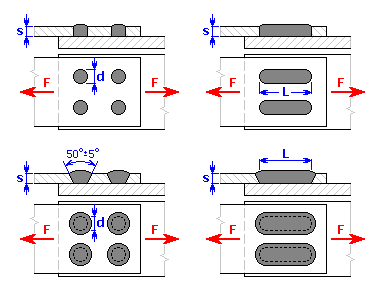
They are similar in the way weld is deposited: both plug weld hold and slot weld slot is completely filled equal to the base metal thickness.
Plug Weld Symbol & Callout
A Plug weld Symbol & callout specify the
- Weld size: Placed on the left side of weld symbol/ Callout
- Plug weld location: shown by arrow line
- Orientation,
- Countersink angle (if applicable): placed outside the horizontal side of weld symbol/ Callout.
- Depth of filling (if specified): Inside the plug weld symbol/ Callout.
- Pitch/ Spacing (center to center distance dimension in case of multiple plug welds): Placed on the right side of Plug weld symbol/ Callout.
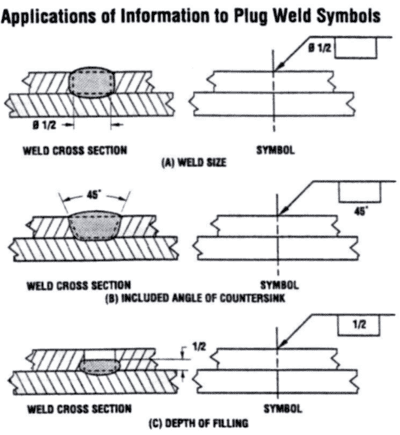
The size of the plug weld (hole diameter) is always given on the left side of plug weld symbol/ Callout.
In below figure, welding symbol for partially filled plug weld is shown. Here, 1/2 is the hole diameter, 1/8 is the depth of plug weld and 45 is the angle of weld preparation for countersunk plug weld hole.
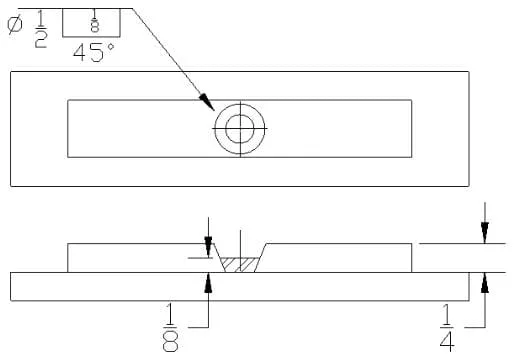
Refer below Plug weld symbol & related information as:
- (5): Number of Plug welds
- 3: Plug weld pitch
Bottom weld symbol/ callout information
- ø3/4: Plug weld size (hole diameter)
- 45°: Countersink size
- (7): Number of Plug welds
- 6: Plug weld pitch
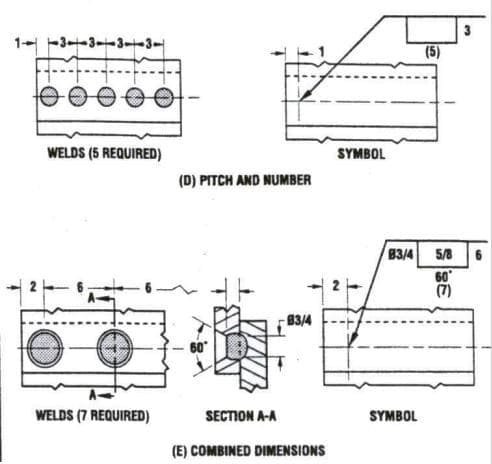
Plug Weld Joint
A Plug weld joint is one of the basic welds joint out of 5 joints. A plug weld joint is a type of welding where a weld is placed in a pre- drilled hole in one member out of two parallel members.
This type of joint is often used to join two pieces of metal together, such as joining two steel plates. Plug welds can be used to join both thin and thick materials. When joining thicker materials, multiple passes may be necessary to build up the weld enough to fill the hole.
Plug Weld Size & Strength
AWS AD1.1 and CSA W59 given the minimum plug weld size (Plug hole diameter) required for welds as:
- Minimum Plug hole diameter (d) = t + 8 mm (as per CSA W59)
- Minimum Plug hole diameter (d) = t + 5/16 inch (as per AWS D1.1 & CSA W59 in inches)
Here, d is the plug hole diameter, t is the plate thickness having the hole.
Minimum size or hole diameter for plug weld in aluminum parts are given in AWS D1.2, Table 2.1 as 3 times of t for less than 1/8 inch ( 3mm) and 2.5 times t for 1/8 inch and higher thicknesses.
Plug Weld Design for sheet metal and thick steel
A plug weld under stresses shear parallel to its faying surfaces and lead to failure of a plug weld. The strength of a plug weld is equal to 0.45 times of weld metal (welding filler wire) tensile strength.
For example, if a welding wire is having a strength of 100 Ksi, the plug weld shall have a maximum tensile strength of 45 Ksi. This condition remains active unless the applied shear stress is below the 0.54 times of base metal yield strength.
It is advised to choose a filler weld of equal or higher strength than the base metal for plug welds. Remember: Plug weld & slot weld are prohibited for Fatigue loading welds.
Plug Welding Standards
Plug Welding standards covers the design, inspection & welding requirements for Plug welds. Most used Plug Welding standards/ Code are:
- AWS D1.1: For steel.
- AWS D1.2: For aluminum.
- AWS D1.3: For sheet metal.
- CSA W59: For steel.
Plug Weld Example
A plug weld is a type of spot weld that is used to join two pieces of metal together. The molten metal from the welding electrode is used to fill the gap between the two pieces of metal.
Plug welds are commonly used in the automotive industry to join sheet metal components together. They are also used in the construction industry to join beams and other structural members together.
Plug Weld vs Spot Weld
A plug weld is created by welding in a hole. The hole is drilled into one member that need to be joined with other member as explained earlier, and then the filling the hole by welding.
This method is often used when joining sheet metals or thicker pieces of metal together.
Spot welding, on the other hand, doesn’t require a hole. Instead, the welder simply applies pressure and heat to two small spots on the sheet metal. This method is typically used for thinner materials.
There are various spot welding processes available such as resistance spot welding, spot mig welding, spot tig welding, etc.
In terms of welding output, spot welds are faster than plug weld but they are limited only for sheet metal welding applications. Plug welds can be made on plates when a spot welder is not available to weld two metals.
Steps for Plug Welding Process
Plug welding is a type of welding technique that involves welding a small, cylindrical plug hole using welding filler wire.
The process is commonly used in automotive and aerospace applications, as well as in the repair of metal structures. Here are the general steps for plug welding:
- Prepare the metal: Clean and degrease the metal surfaces to be welded. Make sure the metal weld area is dry and free of any contaminants.
- Drill the hole: Using a drill machine or gas cutting, drill/ make a hole in the metal where the plug welding is required.
- Clamp the metal: Clamp the metal together to control distortion and hold parts together while welding.
- Weld the plug: Using a welder, weld around the circumference of the plug first, and then fill the hole as per drawing requirements.
- Clean the weld: Once the welding is complete, clean the weld with a wire brush to remove any slag or other contaminants.
- Grind the weld: Use a grinder to smooth out any rough edges or uneven areas on the weld.
- Inspect the weld: Inspect the weld to ensure it is strong and free of defects.
Advantages of Plug weld
A Plug welding joint has several advantages over other types of welding:
- Strong and durable: Plug welds are very strong and durable, making them suitable for use in a wide range of applications, including heavy machinery and equipment, automobiles, and aerospace.
- Cost-effective: Plug welding is a relatively low-cost welding method, making it an economical choice for many projects.
- Versatile: Plug welding can be used on a wide range of metal thicknesses, from thin sheet metal to thick structural steel.
- Easy to repair: Plug welds are easy to repair if they become damaged or worn.
- High precision: Plug welding is a precise welding method, allowing for accurate and consistent results.
- Good for tight spaces: Plug welding is a good choice for welding in tight spaces, as it requires only a small hole to be drilled in the metal.
- Good for joining dissimilar metals: Plug welding is a good method for joining dissimilar metals, as it does not rely on the heat input of the base metal to melt the filler metal.
- Low distortion: Plug welding causes less distortion than other welding methods, which is important in applications where precise measurements are required.
